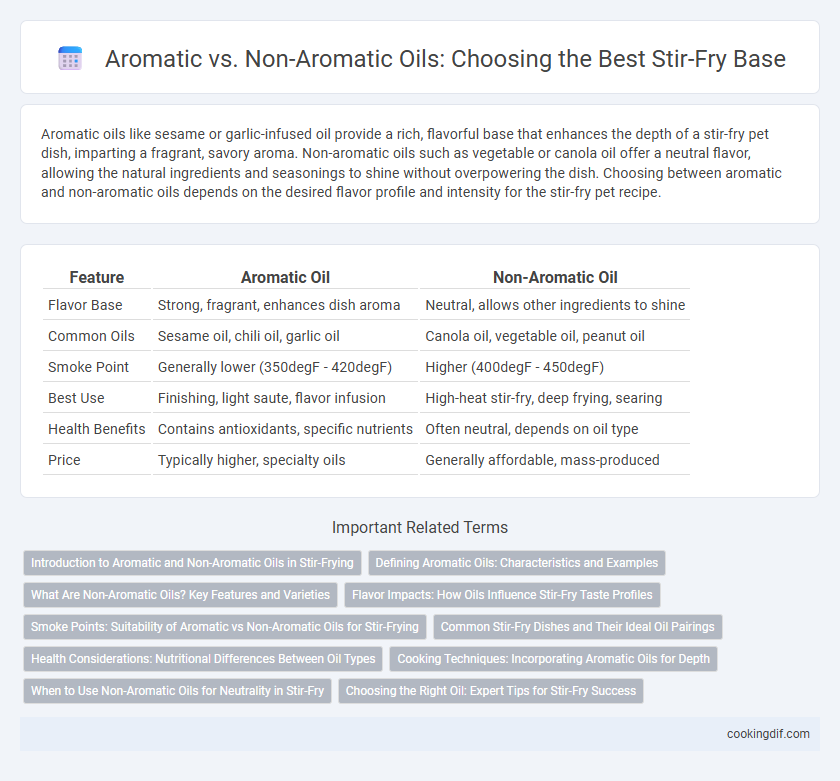Aromatic oils like sesame or garlic-infused oil provide a rich, flavorful base that enhances the depth of a stir-fry pet dish, imparting a fragrant, savory aroma. Non-aromatic oils such as vegetable or canola oil offer a neutral flavor, allowing the natural ingredients and seasonings to shine without overpowering the dish. Choosing between aromatic and non-aromatic oils depends on the desired flavor profile and intensity for the stir-fry pet recipe.
Table of Comparison
| Feature | Aromatic Oil | Non-Aromatic Oil |
|---|---|---|
| Flavor Base | Strong, fragrant, enhances dish aroma | Neutral, allows other ingredients to shine |
| Common Oils | Sesame oil, chili oil, garlic oil | Canola oil, vegetable oil, peanut oil |
| Smoke Point | Generally lower (350degF - 420degF) | Higher (400degF - 450degF) |
| Best Use | Finishing, light saute, flavor infusion | High-heat stir-fry, deep frying, searing |
| Health Benefits | Contains antioxidants, specific nutrients | Often neutral, depends on oil type |
| Price | Typically higher, specialty oils | Generally affordable, mass-produced |
Introduction to Aromatic and Non-Aromatic Oils in Stir-Frying
Aromatic oils such as sesame oil and garlic-infused oil are rich in flavor compounds that enhance the taste profile of stir-fry dishes, releasing their fragrance when heated briefly. Non-aromatic oils like vegetable, canola, or peanut oil have high smoke points and neutral flavors, providing a stable cooking base without overpowering other ingredients. Selecting the appropriate oil balances both aroma and cooking performance, essential for achieving the authentic texture and flavor in stir-frying.
Defining Aromatic Oils: Characteristics and Examples
Aromatic oils are characterized by their strong, distinctive fragrances and flavors that enhance stir-fry dishes by infusing them with layers of complexity. Common examples include sesame oil, garlic-infused oil, and chili oil, which release their aromas quickly at lower temperatures, creating a flavorful base. Non-aromatic oils like vegetable or canola oil have neutral flavors, making them ideal for high-heat cooking without overpowering other ingredients.
What Are Non-Aromatic Oils? Key Features and Varieties
Non-aromatic oils possess neutral flavors and high smoke points, making them ideal for stir-fry bases that require temperature control without altering dish flavors. Common varieties include canola, vegetable, and grapeseed oils, prized for their light texture and heat stability. These oils facilitate even cooking and maintain the integrity of spices and aromatics introduced later in the stir-fry process.
Flavor Impacts: How Oils Influence Stir-Fry Taste Profiles
Aromatic oils such as sesame or garlic-infused oil introduce deep, complex flavors that elevate the stir-fry's overall taste profile by adding nutty or savory notes. Non-aromatic oils like canola or vegetable oil offer a neutral base, allowing the natural flavors of vegetables and proteins to shine without interference. Choosing the right oil directly impacts the stir-fry's aroma and depth, shaping the final taste experience.
Smoke Points: Suitability of Aromatic vs Non-Aromatic Oils for Stir-Frying
Aromatic oils like sesame and peanut oil have moderate smoke points ranging from 410degF to 450degF, providing rich flavors ideal for low to medium-heat stir-frying. Non-aromatic oils such as canola, soybean, and refined avocado oil offer higher smoke points between 450degF and 520degF, making them suitable for high-heat stir-frying without burning. Selecting oils with appropriate smoke points ensures the base remains stable while enhancing the overall taste and preventing harmful smoke production during cooking.
Common Stir-Fry Dishes and Their Ideal Oil Pairings
Common stir-fry dishes such as beef and broccoli, chicken with vegetables, and shrimp with garlic benefit from aromatic oils like sesame or garlic-infused oil to enhance flavor complexity during the initial cooking stage. Non-aromatic oils like vegetable, canola, or peanut oil provide a high smoke point ideal for rapid, high-heat cooking without overpowering the dish's natural taste. Selecting the appropriate oil based on the recipe ensures optimal depth of flavor and texture while maintaining healthful cooking techniques.
Health Considerations: Nutritional Differences Between Oil Types
Aromatic oils, such as sesame or coconut oil, contain beneficial compounds like antioxidants and medium-chain triglycerides that may support heart health and metabolism. Non-aromatic oils, including canola and sunflower oil, offer higher smoke points and generally have a more neutral fatty acid profile with essential omega-6 fatty acids. Choosing oils with balanced unsaturated fats and minimal processing enhances the nutritional value and reduces harmful trans fat exposure when stir-frying.
Cooking Techniques: Incorporating Aromatic Oils for Depth
Aromatic oils such as sesame, garlic-infused, and ginger-infused oils impart rich, complex flavors when used as the base in stir-fry cooking, enhancing the overall depth of the dish. Non-aromatic oils like canola, vegetable, or peanut oil provide a neutral foundation with high smoke points, ensuring quick, even cooking without overpowering the ingredients' natural flavors. Leveraging the nuanced aroma of specialty oils at the start of stir-frying elevates the sensory experience, creating a more vibrant and layered taste profile.
When to Use Non-Aromatic Oils for Neutrality in Stir-Fry
Non-aromatic oils such as canola, vegetable, or grapeseed oil provide a neutral base ideal for stir-frying when the goal is to highlight the natural flavors of fresh vegetables, meats, or sauces without interference. Their high smoke points allow for quick, high-heat cooking essential for traditional stir-fry techniques, preventing oil degradation and off-flavors. Choosing non-aromatic oils ensures the dish's ingredients retain their intended taste profiles, making them perfect for versatile and balanced stir-fry recipes.
Choosing the Right Oil: Expert Tips for Stir-Fry Success
Choosing the right oil for stir-fry significantly impacts flavor and cooking performance; aromatic oils like sesame and peanut impart rich, nutty undertones, enhancing dish complexity. Non-aromatic oils such as canola or vegetable oil provide a neutral base with high smoke points, ensuring efficient heat transfer and preventing burnt flavors. Experts recommend using a blend of both to balance aroma and heat tolerance, optimizing the stir-fry's texture and taste.
Aromatic vs Non-aromatic oil for starting base Infographic

 cookingdif.com
cookingdif.com